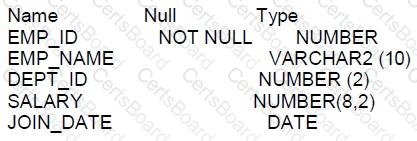Examine the data in the CUST NAME column of the CUSTOMERS table:
CUST_NAME
------------------------------
Renske Ladwig
Jason Mallin
Samuel McCain
Allan MCEwen
Irene Mikkilineni
Julia Nayer
You want to display the CUST_NAME values where the last name starts with Mc or MC. Which two WHERE clauses give the required result?
Examine thee statements which execute successfully:
CREATE USER finance IDENTIFIED BY pwfin;
CREATE USER fin manager IDENTIETED BY pwmgr;
CREATE USER fin. Clerk IDENTIFIED BY pwclerk;
GRANT CREATE SESSON 20 finance, fin clerk;
GRANT SELECT ON scott. Emp To finance WITH GRANT OPTION;
CONNECT finance/pwfin
GRANT SELECT ON scott. emp To fin_ _clerk;
Which two are true?
Which three statements are true about performing Data Manipulation Language (DML) operations on a view In an Oracle Database?
Which three statements are true about defining relations between tables in a relational database?
Examine this description of the PRODUCTS table:
You successfully execute this command:
CREATE TALE new_prices(prod_id NUBER(2),price NUMBER(8,2));
Which two statements execute without errors?
Examine the description of the EMPLOYEES table:

NLS_DATE_FORMAT is set to DD-MON-YY.
Which query requires explicit data type conversion?
Examine the description of the EMPLOYEES table:

The session time zone is the same as the database server
Which two statements will list only the employees who have been working with the company for more than five years?